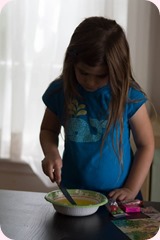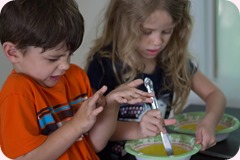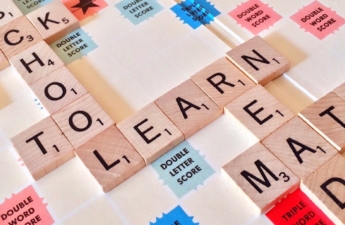S asked me to put together a list of what curriculum we’ve found useful, and—overwhelmed at the magnitude of that task, it finally occurred to me that probably the simplest way to do so is just to explain what we’re actually doing, and a couple sentences about why. One caveat, this is more like “this very month,” because different kids are in different parts of their grades… some of these we JUST started and some are almost finished.

E, age 7
 Saxon Math 54, old edition. This is following on the heels of Singapore Math, which has a totally different teaching philosophy,
Saxon Math 54, old edition. This is following on the heels of Singapore Math, which has a totally different teaching philosophy,- CLE Reading 4 and A Beka Reading 5. Yes, both at the same time. CLE Reading 4 is a half-year course, designed to be filled in with CLE Bible 4 the other half. But we do other Bible. And I want her to read more classic literature than CLE brings in at this point, which is why we’re doing these both simultaneously, every-other-day. A Beka Reading 5 is mostly classic stories, novel excerpts, etc., with some comprehension questions at the end of each selection. (And yes, these are on two different grade levels, primarily because I don’t like A Beka Reading 4, which is not so much classics.) Reading is a very small subject for E right now, and either course only takes her about 15 minutes a day. We will be dropping reading soon in favor of reading actual books (more on that below).
- Sequential Spelling 2. Sequential Spelling is not per grade; the numbers are at least a grade off, and you are supposed to start with 1, generally, regardless of grade level. I LOVE this spelling curriculum. It teaches the patterns of language and spelling by using those patterns, rather than memorization. There’s literally zero memorization. This gives kids both the tools to spell correctly, as well as the confidence to attempt spelling unknown words. It also has a nice DVD program that makes it quite simple to do as independent learning. There are seven levels total, and then no more spelling. 🙂
- Rod and Staff English 3. I really, really love this grammar curriculum. Rod and Staff reminds me a lot of Saxon math, in that you have a textbook and then do actual work in notebooks—this makes it incredibly affordable for multiple children. It’s also very, very solid academically, uses examples from Bible stories and Bible morals, and is apparently attractive enough that it’s been a favorite subject in our house many times. (GRAMMAR is a favorite subject! Just ruminate on that for a while!) It also includes writing.
- Spectrum Writing 4. Spectrum workbooks are great for filling in the cracks. Not really a full-blown curriculum—I don’t think they’re intended to be—but good for using for some weeks or months when things are in transition. In our case, our primary writing curriculum is Tapestry of Grace (more in a minute), but right now, we’re on break from Tapestry as we’re doing really intense science this semester. I didn’t want to totally give up on writing, though, so… a Spectrum workbook is filling in. You can buy most of the Spectrum workbooks as ebooks from Currclick; I’ve used many of them and always been pleased. Similarly this Maps and Geography book is another awesome one for “filling in the cracks” and introducing/solidifying map skills.
- Handwriting Without Tears, Kick Start Cursive. I use HWT for printing, and it is brilliant and excellent and the kids love it, but I desperately fought for about a year to do a different cursive. Because HWT cursive is… hideous, in my opinion! So we tried somewhere around four different cursive curriculums that look more “normal” over the past year and bombed on every single one. If the girls could make the cursive loop de loops (which was often beyond their coordination to begin with), they still couldn’t read the very words they wrote. So finally, very, very reluctantly, we picked up the HWT cursive book. And everything is all better. It’s amazing. HWT cursive, while ugly, has the same basic cursive shapes (like r, z, etc.) but many less loops, flourishes, and no slant. I don’t want them writing it for the rest of their lives, but I think at the very least, it will be a bridge to to the world of cursive, and once they know the basic shapes, and improve in age and coordination a little bit, they’ll be better able to handle the flourishes, loops, and slant of a more old-fashioned cursive.
- Apologia Human Anatomy and Physiology. New for us this year, we’re doing this as an online class! It is going wonderfully so far. Instead of being a one-year course, as we usually do Apologia’s texts, it’s crammed into 12 weeks. It’s a little intense to do all the experiments and notebooking and tests in that timeframe, but I think it’s actually “sticking” better, and the online teacher’s presence is pushing me to prioritize it more, as well as generating a ton of excitement on the part of our little students. 🙂 We’re only about 1/4 of the way through, but at this point, I’m definitely planning to do this over again!
- Tapestry of Grace, year two, upper grammar. We’ve been doing Tapestry for a couple of years, so I’ve written about it before. We use it to cover vocabulary, geography, history, art, and writing. New this year, we’re also going to use it (once science is over for the fall) to cover literature, which is a major change in our school routine: instead of doing “Reading,” from about 5th level on or so, we’ll be fully and wholeheartedly doing the very full literature portion of Tapestry. Literature is “my thing,” so to speak—what I went to school to teach!—and I’m very confident in Tapestry’s literature program through high school. I’m excited to finally have a reader who can handle it. 🙂 I don’t think the lower-grammar level of Tapestry is an adequate substitution for a reading/phonics program, and I don’t think it intends to be.
- Bible Treasures, by Christian Liberty Press. This is another new one for us. It’s a little too easy for E, and a little too hard for L, but I think it will be good and simple for us all to do together.
R, age 5 (almost 6)
- Singapore Primary Mathematics 2A&B. This one I’ve also written about before. BUT. I am increasingly vaguely dissatisfied with Singapore for two reasons: 1) its mastery-style approach leaves our kids alternately overwhelmed or bored; and 2) lack of built-in drilling. For these reasons, we are switching. I can’t switch R, though, because the program I would switch to is too different by 2nd grade—so we’re doing something different from now on, but finishing the course here. It’s a great program and well above grade level… but I need something that includes drills, because I have too much on my plate to handle it myself. Notably we also use Math Rider for drills, as a somewhat easier and a lot more fun alternative to Xtramath (which is free and probably works great for kids 7+, but doesn’t have enough time for younger kids who struggle with keyboarding). Math Rider is somewhat ridiculously pricey, but since we have so many kids to do it, it was a good fit for us.
- CLE Reading 2. I waxed enthusiastic about this already here, and will continue to wax. 🙂 CLE Reading 1-3 is just amazing.
- Spectrum Spelling 2. See above where I said “Spectrum workbooks are great for filling in the cracks.” 😉 R is not quite up to the level to handle Sequential Spelling 1 yet (the word “beginning” is a spelling word in the first set!) and so for the next month or two… Spectrum is getting her used to the idea of spelling and teaching her a little. 🙂
 Rod and Staff English 2. This is the first year offered of R&S English, and it’s great. It is, however, too much reading for a newly-burst 2nd grade reader level—as it was for E at the same stage—so what we do is, I actually teach the lesson. Then she does the exercises. (Later on, they’ll simply read the lesson themselves—E started doing this about 1/3 of the way through the book or so.)
Rod and Staff English 2. This is the first year offered of R&S English, and it’s great. It is, however, too much reading for a newly-burst 2nd grade reader level—as it was for E at the same stage—so what we do is, I actually teach the lesson. Then she does the exercises. (Later on, they’ll simply read the lesson themselves—E started doing this about 1/3 of the way through the book or so.)- Handwriting Without Tears, Kick Start Cursive. Yes, same year as E. I like them working on it together, and it’s entirely possible, because drawing is definitely one of R’s strengths.
- Apologia Human Anatomy and Physiology. She is also doing the online course along with E, but it is quite difficult (3rd-6th grade) and so it’s definitely adapted down. She does the experiments, attends the class, talks about it with E—but it’s all taken down a notch.
- Tapestry of Grace, year two, lower grammar. For R, she’ll do vocabulary, geography, history, and art within Tapestry. Reading is firmly separate at this point, and writing is adequately covered by the R&S English course.
- Bible Treasures.
L, age 4
- CLE Learning to Read. This program is simply amazing. 🙂 It’s workbooks, assumes no prior knowledge (not even the alphabet) and systematically moves students from nothing to a mid-2nd-grade reading level by the end of the year. We love it. The stories are wonderful and wholesome, it’s very Bible-integrated… it’s awesome. As the year moves on, it is integrated with CLE Language Arts 1 and transitions to CLE Reading 1.
- CLE Mathematics 1. This is new for us! But so far it is going very, very well—we’re about 20 lessons in. It has built in drills—lots of them!—and teaches more money and time than Singapore does. It is not as pictorial, which was one of the things I believed was fantastic about Singapore, so I am supplementing with Miquon Math and Cuisenaire rods. LOTS. Like all of CLE’s stuff, it is very easy to follow the teacher manual, the instructions are excellent, it’s workbook based, and there are whole pages that the student works independently.
- Handwriting Without Tears, My Printing Book. I have a feeling that this is a book behind where the girls were at this stage, but I’m not sure. He did the preschool and kindergarten books. We love Handwriting Without Tears.
- Bible Treasures.
E2, age 3
 Horizons Preschool. This is another new one for us, having done mostly Rod and Staff preschool before. Horizons is very methodical and rolls into their Kindergarten, which I am very much hoping to do. Horizons is very colorful and very advanced… and very expensive. The price is definitely the downside. I’m also not loving their theology, but since I’m not trying to use it as our Bible course, it’s pretty easy to leave out. I can’t quite put my finger on what it is I disagree with—it’s just a little too simplistic about spiritual things (“God is my friend” type stuff). That said, I don’t know of a really comparable curriculum that is so effectively methodical and challenging for preschoolers, and right now it is suiting us better than Rod and Staff.
Horizons Preschool. This is another new one for us, having done mostly Rod and Staff preschool before. Horizons is very methodical and rolls into their Kindergarten, which I am very much hoping to do. Horizons is very colorful and very advanced… and very expensive. The price is definitely the downside. I’m also not loving their theology, but since I’m not trying to use it as our Bible course, it’s pretty easy to leave out. I can’t quite put my finger on what it is I disagree with—it’s just a little too simplistic about spiritual things (“God is my friend” type stuff). That said, I don’t know of a really comparable curriculum that is so effectively methodical and challenging for preschoolers, and right now it is suiting us better than Rod and Staff.- Miquon Math. Like with L, we’re integrating Cuisenaire rods into our curriculum beginning as early as possible. 🙂 Another word about Miquon: it begins at the beginning and by the end is covering very advanced (like 5th grade) concepts. Previously we did Singapore Math Essentials K (E, R, and L all did) but I might switch to simply Miquon, depending on how it goes.
Some General Observations
People looking into homeschooling for the first time often ask us what we are doing or what we recommend, so to that end, I wanted to make a few more clarifying remarks about curricula that we use, partly use, have used, or won’t use. 🙂 If you’re new, consider what style of homeschooler you are. Do you want to open a textbook and go? Or do you want to experiment and have student-led learning? Or do you want to base your learning on books? This is an important question. I hover between textbook and living-book-based, which, importantly, means I am not fluent in the more freestyle type of curricula. I’m also pretty big on scheduling and structure. There’s a whole ‘nother world out there of more flexible curricula that I just… totally don’t have the comprehension to even begin talking about. I’m not child-led.
School-in-a-box
- My Fathers World—we did K of this last year, and really tried to give it a good shot. It didn’t go well. It was fun and crafty, but just not at all challenging enough. I know a lot of people who really rave about MFW, and I can’t speak to the upper levels, but I was tremendously disappointed in it. I would not recommend MFW and will not be trying it again.
- Christian Liberty—Christian Liberty puts out a lot of really solid stuff, very affordable, and very Reformed (notwithstanding that they use a good bit of very-Arminian A Beka curriculum). While they don’t make our lists above except for Bible, we use a TON of their books as extracurriculars. There’s something about the curriculum that just doesn’t quite work for us (a little too textbook-oriented, a little too patriotic, a little too A Beka dependent?) but I wouldn’t hesitate in applauding the curriculum to a new homeschooler who was looking for an all-in-one solution. Their first-grade box is $209, including everything. They also have a number of satellite-school kind of options.
- A Beka—A Beka is very tried-and-true. Their phonics program is very advanced, and the manipulatives and so on that go with it are wonderful, colorful, and fun. We still use lots of pieces of A Beka K5, and many other bits of their curriculum. What I really dislike here is the theology and the price. For first grade, you need the child kit and the parent kit for a combined total of over $400. They also offer enrollment options. As far as the theology, they are patriotic to the point that even our kids recognize and call it idolatry, and also Arminian, although I have honestly not noticed that very much, beyond a glorification of people like Billy Sunday that we would not want to emulate.
- Sonlight—Sonlight makes A Beka look amazingly affordable—their first-grade package clocks in at $849. Yeah, really. It’s shocking. I haven’t used Sonlight, but we HAVE used a ton of the same resources that Sonlight puts in their box, and they’re all top-notch. Unlike Christian Liberty or A Beka, Sonlight is very living-book oriented, and they pick absolutely great books. And then they have textbooks for math, and science kits all neatly assembled. It is way more decentralized than I could handle with all our kids running around (although it’s very similar to what we’re moving towards in upper grades with Tapestry of Grace), and it’s expensive, and theologically generic, but… this is a box of really great stuff. If I only had one kid, it wouldn’t surprise me if I was doing Sonlight straight out of the box. As it is, I keep an eye on what they’re using, what books they’re suggesting, because they’re fantastic ideas.
- Christian Light—yes, we use a ton of Christian Light stuff, but I wanted to make some more general comments. They don’t have a “box” of curriculum, but they do have all subjects, and if you add up all their first grade subjects, you end up at about $340, including all teacher’s manuals and almost all manipulatives. Christian Light is very much the spine of our first grade, but I don’t use their science, Bible, or social studies. I think their science is very good, but it doesn’t work for our larger family as well as Apologia, and their Mennonite-ness, while it’s fantastic for underscoring the importance of Scripture and holiness in their reading and math curricula, is just a little too much in Bible, and the marginal separatism is a little too much in social studies. (Not that they are bad, at all, just not as strong on what I’d like them to be strong on. And I would add that I don’t find their theology half as troubling as A Beka or Alpha Omega [Horizons], because I get the impression that, whatever their flaws, they love Scripture more than they love their theology, if that makes sense!) That said, CLE is a very, very solid curriculum, and the only one of all these that is workbook-based, which is a really brilliant format for 1-3 grades at least. The kids learn their stuff, don’t get frustrated, and go on to test very well on achievement tests. So far all of our kids have loved all of the CLE subjects I’ve ever “let” them do, and they beg for more! Rod and Staff is worth mentioning here as well, as it is almost identical in both strengths (rigor, consistency, price, Scripture-saturation) and weaknesses (theology) but a different approach (R&S is textbook, not workbook, and mastery, not spiral). 1st grade Rod and Staff is $279—and they have a cheaper package, as well.
Individual Subjects—miscellaneous remarks
- Notgrass history—I’ve only very recently discovered this, and I’ve been very impressed. Tapestry of Grace is awesome, academically and theologically. There is no curriculum we use that I am in as much accord with as Tapestry. What is not awesome about Tapestry of Grace is that it’s about as expensive as Sonlight, even painstakingly collecting curriculum from used sources. Notgrass is a very real alternative that ends up to be a lot cheaper, and I’m downright impressed by their textbook and lesson plans. Am I going to switch from Tapestry? No. If I had fewer children, would the price tag make me seriously consider Notgrass? Absolutely. And I’m using Notgrass as a supplement. In the same category of like-Tapestry-but-cheaper, there is Biblioplan, which is just… not quite as well done, in my opinion, but again, much cheaper; Story of the World, which is vaguely integrated with Tapestry but a complete program in its own right—and which I don’t use too much because it’s a little too liberal, both in theology and in facts, but nevertheless, it’s a solid curriculum; and The Mystery of History, which I’ve honestly never looked at, but have heard is more theologically sound than Story of the World.
- Math: just one remark: I notice a lot of people switching to a curriculum and suddenly being “so much happier”, and thinking it’s because the curriculum is working better… when what they’ve really done is switched to a curriculum that’s a full year behind the one they were doing, and so of course it’s going better, because the student is now essentially repeating the year. There’s one particular curriculum that is pretty famous for this. Bottom line: poke around to figure out how your curriculum stacks up in terms of levels to other curriculum.
- Math Mammoth: The Math Mammoth workbooks (the Blue series) have been a tremendous resource for us as a way to recap or review a subject that just wasn’t quite adequately covered in the kids’ textbooks. It is great to be struggling with, say, multiplication of numbers under 5 in the regular textbook, and take a week or two detour in Math Mammoth, and come back not only solid in multiplication under 5, but multiplication all the way to 12. This is one of the great benefits of homeschooling—being able to adapt on the fly—and Math Mammoth is a great tool. We have especially used Multiplication, Money, and Time as we’ve worked through Singapore. The curriculum proper (the Light Blue series) is very similar to Singapore, with a little more spiraling, but slightly behind Singapore’s level. I have not been inspired to switch, but it is a respectable curriculum. Very, very similarly, MEP is a very solid, and free, curriculum. I like printed books, if you can’t tell, and MEP is hard for me to figure out what goes where (too many PDFs!), but it is definitely a very solid curriculum.
- Rod and Staff Bible—see the caveats about using a Mennonite (five-point Arminian) curriculum above, but, that said, Rod and Staff’s Bible curriculum is verrrrry Bible-centric. Basically, read the passage, answer the questions. It starts in fifth grade. If I had the time to really meticulously go through it and catch any errant theology, it is by far the most thorough Bible curriculum that I’ve found.
- A Reason for Handwriting—one day, we will have a child who is coordinated enough to not use Handwriting Without Tears, Lord willing, and then we’ll use A Reason for Handwriting. 😉 Nothing better than Bible-based penmanship! Unfortunately, it’s frustrated the living daylights out of every child I’ve tried it with—they just aren’t old enough, I think.
Book Recommendations
- The Games for Learning series by Peggy Kaye, including Games for Math and Games for Reading are really wonderful for at least PreK through second grade or so. Many games are purely oral and can be done on car trips, etc., but they are carefully aimed to teach or reinforce important skills.
- Teach Your Child to Read in 100 Easy Lessons by Siegfried Engelmann is exactly what it says. It takes some time and effort (to create materials), but it’s extremely straightforward and simple and has a proven track record. It is possible to do around late threes, in my experience. That said, with our chaotic lives, I have found it preferable to do a full curriculum that goes a little slower but plods along dutifully and with a little less Mommy guidance. But for an eldest child, in particular, this is a very inexpensive program that’s well worth looking at!
Computer Programs
- Starfall is one that we consistently subscribe to because it is fun and easy for kids to navigate, and reinforces whatever they are learning in phonics. The math games are also very good. And now they have an amazing Android app, finally! That said, I don’t see it as a complete, open-and-go phonics curriculum—but it also isn’t priced as a complete curriculum. It’s quite reasonable.
- Reading Eggs is one that we have done, and I’ve found that it successfully teaches some phonics skills. However, it looks like a complete curriculum, and we never found it to work well enough for that. The exercises are great, but the progression / computer intelligence just isn’t. And there are a few exercises that are just too hard mixed in with ones that are easy. It would, in my opinion, make a great supplement, if they made it easier for the teacher to assign which sounds/exercises to study, and if it was priced more like a supplement and less like a curriculum. Teach Your Monster to Read is an extremely similar program (totally different visual theme)… but free.
- Headsprout is a complete curriculum, and it works. It very single-handedly taught E to read. It’s a very smart program with great, non-frustrating exercises, and hits on all the major components of learning to read—blending, letter identification, etc. However, since E did it a couple of years ago, the company has been bought, the program has been restructured a little bit (there used to be actual paper books, maps, and puppets to go with the program), and the pricing has doubled. Primarily because of the price, I don’t go around recommending it anymore. It was expensive enough to begin with! That said… it works. If I ever have a child who is not doing well with phonics regardless of what I try, I would not hesitate very much to go right back to Headsprout even with the new price. It’s really excellent. However: 1) it doesn’t seem to work with younger children [we have not had success with young 4 year olds or younger], and 2) it doesn’t do a lot of good for older children who are already “getting” phonics [R did it at age late 4 – early 5, and did it successfully, but was clearly learning more from her actual book curriculum].
- Explode the Code—this famous series of books (good in their own right; I use them supplementally at times) is summarized in a lovely computer program which can usually be gotten from the Homeschool Buyers Co-Op for around $35 (much cheaper than retail). We have used this quite a bit, usually around 2nd grade, with kids who are already reading but need some extra reinforcement. It’s easy to log into the teacher portal and assign the student a specific lesson (a specific phoneme, usually) to study. It’s very useful and totally worth $35/yr.
- Xtramath continues to be a necessary mention for its simplicity and free-ness. Khan Academy is also, of course, very widely used by homeschoolers… but my kids hate it. I’ve tried more than once. :-\ But maybe it will work for you!
- Hooked on Phonics Android app is the most full-featured phonics app I’ve stumbled across. It ends up being around $30 after in-app purchases, if I remember right.
Website Resources
- Teachers Pay Teachers is full of very graphically appealing items for classrooms. Alphabet charts, wall posters, printable games, etc. There are SOME worksheet packets. Almost everything costs money. If I need a poster, this is where I look. If I need review of some topic (usually phonics), this is one of the places I look—but I’ll comparison shop and look for free stuff on Google, too.
- Currclick is MUCH less flashy, but generally, much more useful. Currclick has actual curriculum, ebooks, very long pdfs. It’s mostly not graphically appealing, and seems to be much more used by homeschoolers (whereas TpT seems mostly brick-and-mortar schoolers), although I don’t know why. They carry a lot of items by very reputable publishers, both secular and Christian.
- Scholastic, similarly, has a very large and useful PDF collection. They have a subscription plan, but the best deal (in my opinion :-)) is found in their dollar days, when MANY of their books can be downloaded for $1-$2. I stock up on whatever looks useful, and then when I need something, I go hunting through my own collection.
- Twinkl is a UK-based site, so sometimes the spelling is off, but… it’s pretty awesome. Their selection is not unlike Teachers Pay Teachers (i.e. posters and visual resources galore!) but there’s clearly a lot of money behind the development, and they have some really, really, REALLY great resources. Not a lot of workbooks/worksheets—although there’s some—but Twinkl is really brilliant at bringing visuals into the classroom, and their visual resources for stories, history, science… every subject, really… are extremely adequate. It’s quite pricey, but not as pricey as buying the same sort of items on Teachers Pay Teachers time after time. More importantly, Twinkl has some absolute gems that help me be a better teacher. Things that I see them just browsing through on the site, and it’s like, wow, I never would have even thought of that existing, but that will be such a useful resource in our classroom.


It sounds like you’ve got your year figured out really well. Thanks for the link up to my Math explanations post! 🙂